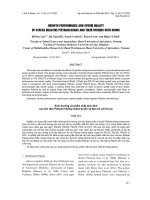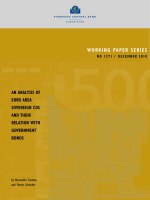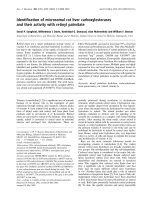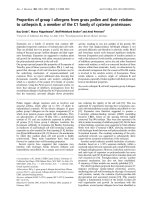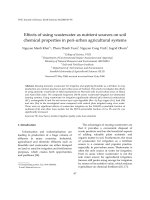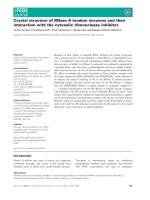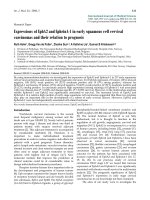Evaluation of soil nutrient index and their relation with soil chemical properties of washim road farm of Dr.PDKV Akola, Maharashtra, India
Bạn đang xem bản rút gọn của tài liệu. Xem và tải ngay bản đầy đủ của tài liệu tại đây (204.28 KB, 7 trang )
Int.J.Curr.Microbiol.App.Sci (2019) 8(9): 1773-1779
International Journal of Current Microbiology and Applied Sciences
ISSN: 2319-7706 Volume 8 Number 09 (2019)
Journal homepage:
Original Research Article
/>
Evaluation of Soil Nutrient Index and their Relation with Soil Chemical
Properties of Washim Road Farm of Dr.PDKV Akola, Maharashtra, India
Vijay A. Dhotare*, V. D. Guldekar, S. M. Bhoyar and Sagar N. Ingle
Department of Soil Science and Agricultural Chemistry, Dr. PDKV, Akola-444 104
Maharaashtra, India
*Corresponding author
ABSTRACT
Keywords
nutrient status, grid
survey, GPS,
chemical property,
macronutrients,
micronutrient,
correlation, nutrient
index
Article Info
Accepted:
20 August 2019
Available Online:
10 September 2019
The present study was conducted during the year 2018 and 2019 at Department of Soil
Science and Agricultural Chemistry, Dr Panjabrao Deshmukh Krishi Vidyapeeth, Akola,
Maharashtra with an aim to know the macro and micronutrient status of soils of Washim
road farm, Dr. PDKV Akola. Grid based (GPS) forty-four (44) surface (0-20 cm depth)
soil samples were collected by grid survey method at 200m distance from Washim road
farm and analyzed as per standard procedure for judging chemical properties and available
nutrient status of soil. The results indicate that all the soils were slightly alkaline to
moderately alkaline in reaction and free from soluble salt hazard. Organic carbon content
were ranged from 2.34-8.97 g kg-1, soils of Washim road farm was moderately calcareous
to calcareous due to presence of CaCO3 in soil. Nutrient index value (NIV) showed
moderate for organic carbon, phosphorus and available Sulphur whereas moderately high
for CaCO3, very low for available N and very high for available potassium. Among
available micronutrients Fe, Zn, Mn showed low nutrient index value (NIV), Cu found to
have high nutrient index for Washim road farm. In Washim road farm statistical
correlation ship showed significant and positive correlation of organic carbon with ECThe
DTPA extractable Fe (r= 0.303*). and Mn (r= 0.321*) showed positive and significant
correlation with available N.
Introduction
Soils are inherently heterogeneous in nature,
diverse and dynamic system and its properties
change in time and space continuously.
Heterogeneity in soil properties with depth
and across landscapes can be accounted for by
several interacting factors that operate with
different intensities and at different scales and
acting simultaneously. Soil is a medium for
plant growth and development that leads to
crop productivity. Crop productivity depends
on many factors and soil fertility is major
branch amongst all. Soil fertility has direct
relation with crop yields, provided other
factors are in optimum level. Soil fertility
must be periodically estimated as there is
continuous
removal
of
macro
and
micronutrients by crop intensively grown in
every crop season. The availability of soil
nutrients for plant growth and yield production
is а function of different parameters, including
1773
Int.J.Curr.Microbiol.App.Sci (2019) 8(9): 1773-1779
soil pH, soil organic matter and texture, and
soil biological activities. Hence, determination
of such parameters is important for evaluating
nutrient behavior in the soil and for suggesting
appropriate methods of enhancing nutrient
availability to plant. (Shazia et al., 2017)
All researches in soil fertility have one
common goal that is to assess nutrient
supplying capacity of the soil, deficiencies of
nutrient if any and to supply nutrient based on
crop needs. Thus, in the game of crop
production, there are three dependent and yet
interdependent players the soil, the plant and
fertilizers, each one of them key players
(Goswami, 1999).The challenge during the
next millennium is to achieve and sustain
growth rates high enough to feed the swelling
population without degrading the environment
(NAAS, 1997).The fertility status of soils can
be evaluated by using nutrient index method
and fertility indicators. Ravikumar and
Somashekar (2013) evaluated the nutrient
index of soils using organic carbon, available
P and available K concentrations as a measure
of soil fertility in Varahi River basin, India.
The aim of this contribution is to describe
spatial distribution of basic soil properties and
vulnerability coefficient on the Washim road
farm and to analyse statistical relationship
between soil properties.
Materials and Methods
The Washim road farm lies between longitude
76°59’42.7”
to
76°59’34”E,
Latitude
20°40’42” to 20°40’58”N. Total 44 surface
soil samples with (0-20 cm depth) from
cultivated area of the washim road farm Dr.
PDKV, Akola were collected using Global
Positioning System (GPS) at grid interval of
200 m. The grid wise sample were collected,
the sample were labeled, air dried and sieve
through 2 mm sieve for analysis of soil
fertility parameter.
Soil pH and electrical conductivity at 1:2.5
soil water suspensions (Jackson 1973).
Organic carbon was measured by Chromic
acid wet digestion method (Walkley and Black
1934). And CaCO3 was determined by rapid
titration method (Piper 1966). Available N
was determined by method described by
Subbiah and Asija (1956), the available P was
colorimetrically as per Jackson (1973), the
available K was estimated by extracting the
soil with 1 N NH4OAC (pH 7.0) by using
flame photometer (Jackson, 1973) and
Available Sulphur was estimated by 0.15%
CaCl2extractable method (Piper, 1966). While
the available micronutrient cation (Fe, Mn, Zn
and Cu) were extracted by DTPACaCl2extract (Lindasay and Norvell,1978).The
soil nutrient index was calculated according to
the procedure given by Ramamoorthy and
Bajaj (1969).
Results and Discussion
The results presented in (Table 1) revealed
that the pH of the soils of Washim road
farm, were ranged from 7.50 to 8.60
indicating slightly to moderately alkaline in
reaction. The alkaline reaction of soil is
probably due to presence of sufficient free
lime content in these soils (Jibhkate et al.,
2009).The EC ranged from 0.13 to 0.38
dSm- and suitable for healthy plant growth.
(Padole and Mahajan, 2003) The EC value
<1.0 indicate that these soils are free from
hazard of soluble salts as prescribed by
Richards (1954).
The soils were low to moderately high in
organic carbon content (2.34 to 8.97 g kg-1)..
The low content of organic carbon might be
due to slow rate of decomposition and
continuous utilization by plants for the
uptake of nutrients. Similar results were
reported by Patil et al., (2008) in the soils of
Agriculture college farm, Pune.
1774
Int.J.Curr.Microbiol.App.Sci (2019) 8(9): 1773-1779
The free lime content ranged from 4.25 to
10.0 %. It indicates that these soils are
moderately calcareous (18%) to calcareous
(82%) in nature.
The data presented in (Table 1) revealed that
the available nitrogen in Washim road farm
ranged from 100.35 - 175.61 kg ha-1. Similar
observations were also recorded by Dhale and
Prasad (2009). As per rating standard, soils of
Washim farm low in available nitrogen
content. The soils thus need judicious
application of both organic manure and
nitrogenous fertilizers to meet the N
requirement of crops grown in them.The
available phosphorus ranged from 13.25 to
22.4 kg ha-1 in Washim road farm.The
variation in the availability of phosphorus
might be due to variation in CaCO3 content of
the soil, different soil properties and
agronomic practices. The result closely point
by Bharambe et al., 2001.The available
potassium for Washim road farm soil ranged
from 340.14 to 539.05 kg ha-1. As per ratings,
soils containing available potassium more than
300 kg ha-1 categorized as very high in
available potassium content. The data on the
basis of available potassium content indicates
that the soils have no problem of K deficiency.
Similar results were also reported by Kashikar
(1983)for black soils.Sulphur ranged from
7.58 to 16.4 mg kg-1. As per ratings, soils
containing available Sulphur more than 20 mg
kg-1 categorized as very high in available
Sulphur content. Low available Sulphur in
these soils may be due to the less supply of
Sulphur containing fertilizers. The results
closely confirmative with (Wagh et al., 2008)
The DTPA extractable Fe content in soils of
ranged between 2.05 to 5.96 mg kg-1,
considering critical limit for DTPA –Fe 2.54.5 mg kg-1 as given by Katyal and
Rattan(2003) these soils are found to be
sufficient in available Fe content it is due to
the increased in CaCO3 and clay content in the
soils (Jibhkate et al.,2009).Magnitude of
available manganese content in soils ranged
from 0.82 to 4.47 mg kg-1 indicates very low
to medium status. The available zinc extracted
by DTPA varied from 0.12 to 0.88 mg kg-1 for
soils under study are categorized as a medium
in available zinc status. Similar observation
was recorded by Gajbhiye et al., (1993).
The available copper extracted by DTPA
ranged between 0.73 to 3.12 mg kg-1.
Considering critical limit of 0.2 mg kg-1 as
suggested by Katyal and Rattan (2003), these
soils are categorized as high in available
copper content. Similar results were reported
by Jibhkate et al., (2009).
Nutrient Index Value
As per the NIV developed by Ramamoorthy
and Bajaj (1969) the nutrient index values
were calculated for Washim road farm of the
University, to know the fertility status of these
soils (Table 2). The soil nutrient index value
of Washim road farm calculated for organic
carbon content was 1.73 with moderate
category. Nutrient index value calculated for
calcium carbonate was 1.90 with moderately
high category. As regards the available
nitrogen content nutrient index value was 0.75
with very low category.
Phosphorus the major important nutrient in
terms of plant growth was available in
moderate category with NIV 1.57. nutrient
index value for potassium shows very high
with 3.0 NIV.
As per the NIV developed by Ramamoorthy
and Bajaj (1969) the nutrient index values
were calculated for Washim road farm of the
University, to know the fertility status of these
soils (Table 2). The soils of Washim road farm
showed low nutrient index value (NIV) for
available Zn, Fe, Mn i.e. 1.04, 1.12 and 1.35,
respectively.
1775
Int.J.Curr.Microbiol.App.Sci (2019) 8(9): 1773-1779
Table.1 Status of Nutrient for Washim road farm of the University
No. of
sample
analysed
44
Parameters
Range
Mean
VL
L
pH
EC (dSm-1)
OC (g kg-1)
7.5-8.6
0.13 - 0.38
2.34- 8.97
7.95
0.25
5.88
0
3 (7%)
CaCO3
4.25- 10.0
6.98
0
0
N (kg ha-1)
100.35175.61
13.25-22.4
139.7
2
18.01
22
(50%)
0
22
(50%)
2 (5%)
420.7
7
11.51
0
S ( mg kg-1)
340.14539.05
7.58- 16.4
0
Fe ( mg kg-1)
2.05- 5.96
4.06
4 (9%)
Mn ( mg kg1
)
Zn ( mg kg-1)
0.- 4.47
2.63
0.12- 0.88
0.46
Cu ( mg kg-1)
0.73- 3.12
1.78
7
(16%)
11
(25%)
0
P (kg ha-1)
K (kg ha-1)
Ratings
M
Mod. H
NIV
1.73
1.90
0.75
1.57
3
1.40
1.12
1.35
1.04
2.73
1776
VH
17
(39%)
8
(18%)
0
23 (52%)
1 (2%)
0
36 (82%)
0
0
0
0
0
9 (20%)
0
0
0
33
(75%)
0
0
0
12
(27%)
25
(57%)
8
(18%)
18
(41%)
0
28
(64%)
15
(34%)
20
(46%)
15
(34%)
0
4
(9%)
0
0
44
(100%)
0
0
0
9 (20%)
0
0
0
0
0
1(2%)
6
(14%)
37
(84%)
Table.2 Status of Nutrient Index Value (NIV) for Washim road farm
Elements
OC (g kg-1)
CaCO3 (%)
Avail. N (kg ha-1)
Avail. P (kg ha-1)
Avail. K (kg ha-1)
Avail. S (mg kg-1)
Avail. Fe (mg kg-1)
Avail. Mn (mg kg-1)
Avail. Zn (mg kg-1)
Avail. Cu (mg kg-1)
H
Category
Moderate
Mod. High
Very Low
Moderate
Very High
Moderate
Low
Low
Low
High
Int.J.Curr.Microbiol.App.Sci (2019) 8(9): 1773-1779
Table. 3. Relationship between soil chemical properties with available macro and micronutrients in Washim road farm
EC
pH
pH
1
OC
CaCO3
Avail. N Avail. P
EC
-0.019
1
OC
-0.131
0.308*
1
CaCO3
-0.219
-0.118
-0.073
1
Avail. N
0.137
-0.009
-0.053
-0.031
1
Avail. P
0.293
0.169
-0.239
-0.252
0.29
1
Avail. K
-0.142
-0.224
-0.012
-0.092
-0.006
0.113
1
Avail. S
0.062
0.062
0.164
-0.146
0.143
0.420**
0.148
1
Fe
0.135
0.244
-0.049
0.071
0.303*
0.152
-0.266
0.111
1
Mn
0.068
0.276
0.055
-0.07
0.321*
0.284
-0.295
0.084
0.186
1
Zn
0.138
-0.06
0.201
0.112
-0.152
-0.114
0.099
-0.04
0.142
-0.320*
1
Cu
-0.151
-0.042
0.009
-0.088
-0.146
0.016
-0.172
-0.253
0.107
0.122
-0.18
*Significant at 5% level of significance
** Significant at 1% level of significance
1777
Avail. K Avail. S Fe
Mn
Zn
Cu
1
Int.J.Curr.Microbiol.App.Sci (2019) 8(9): 1773-1779
This soil was in category of very high nutrient
index value (NIV) for available Cu i.e. 2.73.
The details of soil nutrient index of
micronutrients for Washim road farm of the
University presented in the Table 2.
Correlation
The overall correlation studies between
chemical properties and available macro and
micronutrients for Washim road farm was
analysed and presented below.
In Washim road farm statistical correlation
showed significant and positive correlation of
organic carbon with EC which is evident by
‘r’ values of 0.308*. The DTPA extractable Fe
(r= 0.303*). and Mn (r= 0.321*) showed
positive and significant correlation with
available N. Similarly, available zinc showed
significantly but negative correlation with Mn
of soil. (r= -0.320*). It was observed that
available S showed positive and significant
relation with available P (r=0.420*) in the soil.
It can be concluded that, the soils of Washim
road farm are slightly alkaline to moderately
alkaline in soil reaction, safe in electrical
conductivity, low to moderate high in organic
carbon content and moderately calcareous to
calcareous in nature. According to the concept
of soil nutrient index soils are very low in the
available N, medium in P, high in K and
medium in S content. Nutrient index for
micronutrients are low in available Fe, Mn, Zn
and high in available Cu content.
References
Bharambe, P. R., Kadam S. G., Shinde S.D.,
and
Shelke
D.K.,
2001.
Characterization of soils Majalgaon
canal command area (Jayakwadi
project stage II) J. Indian Soc. Soil
Sci.47 (4) : 749-754.
Dhale, S.A. and Jagdish Prasad. 2009.
Characterization and classification of
sweet orange growing soils of Jalna
District, Maharashtra, Journal of the
Indian Society of Soil Science, Vol. 57,
No. 1, PP 11-17.
Gajbhiye, K.S., S.T. Gaikwad, J.L. Sehgal
and Ratna Gupta. 1993. Micronutrient
status and deficiency delineation in
Vertisols and their intergrades – A case
study
of
Saongi
Watershed.
Agropedology, 3.
Goswami NN. 1999. Raychaudhuri memorial
lecture. Priorities of soil fertility and
fertilizer use research in India. Journal
of the Indian society of soil science.
1999; 847(4):649-660.
Jackson, M.L. 1973. Soil chemical analysis,
prentice Hall of India. Pvt. Ltd., New
Delhi, p. 498.
Jibhakate, S.B., M.M. Raut, S.N. Bhende and
V.K. Kharche. 2009. Micronutrient
status of soils of katol tahasil in
Nagpur District and their relationship
with some soil properties. J. Soils and
crops 19(1) 143-146.
Kashikar, C.G. 1983. Characterization of clay
fraction from black soils. M.Sc. (Agri.)
Thesis (Unpub). PKV, Akola.
Katyal. J.C. and Rattan R.K. 2003. Secondary
and micronutrients research gaps and
future needs. Fertilizers news vol. 48
(4), pp 9-14 & 17-20 (10 pages).
Lindsay, W.L. and W.A. Norvell, 1978.
Development of a DTPA soil test for
zinc, iron, manganese and copper, Soil
Sci. Soc. America J., 42: 421-428.
NAAS. 1997. Crop response and nutrient
ratio. NAAS Policy Paper No. 42 (R.
Prasad and P.S. Pathak, Eds), National
Academy of Agricultural Sciences,
New Delhi.
Padole VR. and Mahajan SB. 2003. Status
and release behavior of potassium in
Swell-Shrink soils of Vidarbha,
Maharashtra, J. Maharashtra agric.
Univ, 2003; 28(1):3-7.
Piper, 1966. Soil and Plant analysis, 135-136,
1778
Int.J.Curr.Microbiol.App.Sci (2019) 8(9): 1773-1779
Hans Publishers Bombay.
Ramamoorthy B, Bajaj JC. 1969. Available
N, P and K status of Indian soils.
Fertilizer News. 14:24-26.
Ravikumar P., Somashekar R.K. 2013.
Evaluation of nutrient index using
organic carbon, available P and
available K concentrations as a
measure of soil fertility in Varahi
River basin, India. Proceedings of the
International Academy of Ecology and
Environmental Sciences, 2013, 3(4):
330-343.
Shazia Ramzan, Mushtaq A. Wani. and
Auyoub Bhat M., 2017. Assessment of
Spatial Variability of Soil Fertility
Parameters
Using
Geospatial
Techniques in Temperate Himalayas.
International Journal of Geosciences,
2017, 8, 1251-1263.
Walkley, A.J. and Black I.A., 1934.
Estimation of soil organic carbon by
the chromic acid titration method. Soil
Sci., 37: 29-38.
Wagh, S.P., Ommala D. Kuchanwar and Renu
V. Haware. 2008. Nutritional Status of
Acid lime orchards in Akola District.
PKV Res. J. Vol. 32 (2).
How to cite this article:
Vijay A. Dhotare, V. D. Guldekar, S. M. Bhoyar and Sagar N. Ingle 2019. Evaluation of Soil
Nutrient Index and their Relation with Soil Chemical Properties of Washim Road Farm of
Dr.PDKV Akola, Maharashtra, India. Int.J.Curr.Microbiol.App.Sci. 8(09): 1773-1779.
doi: />
1779
